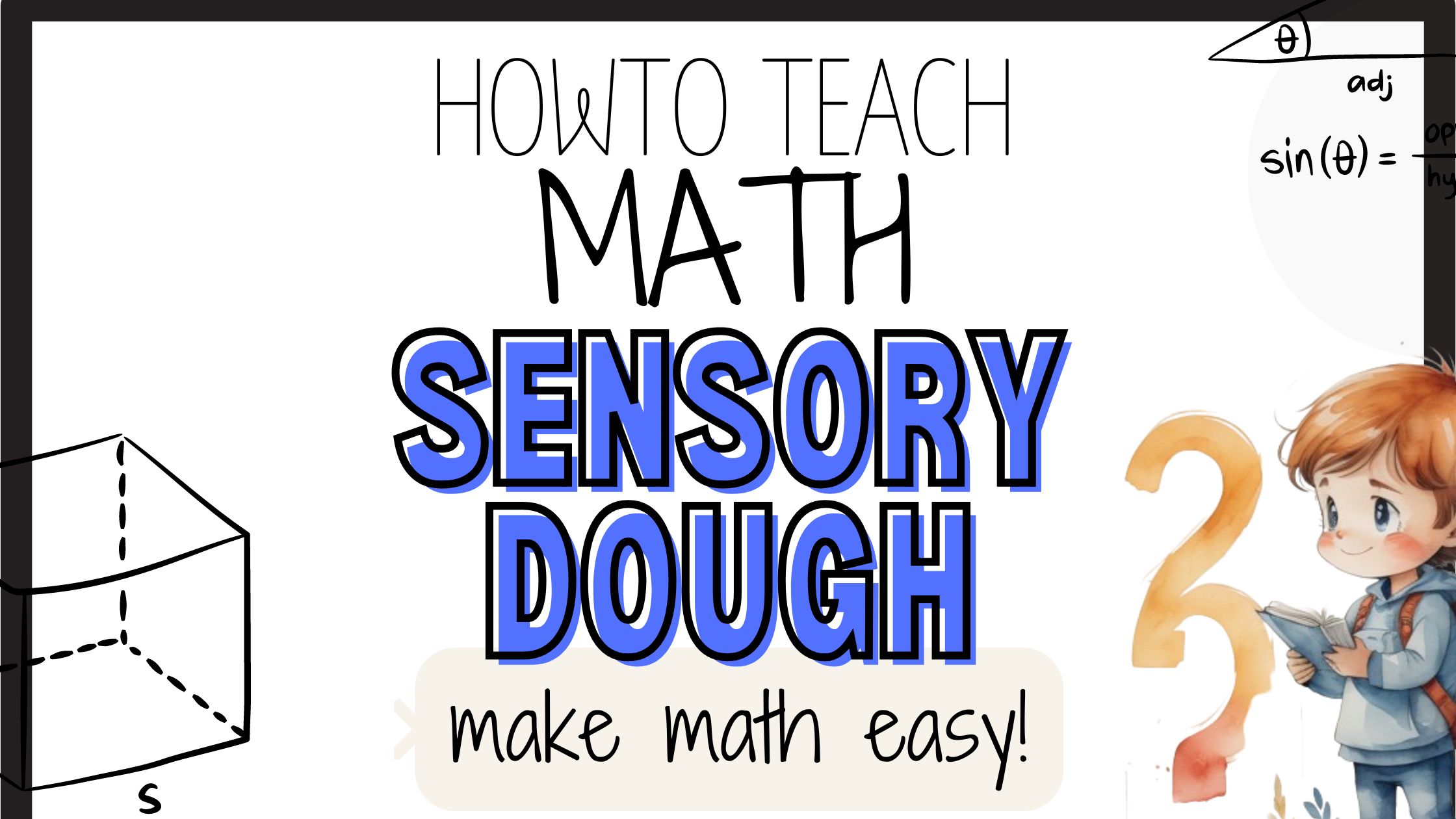My niece started school. So I’ve been looking into some teaching games. Sensory dough is a fantastic tool for engaging kids in play, but did you know it can also be an amazing resource for teaching math skills? 📚✨ Incorporating math lessons into sensory play makes learning fun and interactive, allowing children to grasp concepts through hands-on experiences. Today, I’ll share with you how to use sensory dough to teach various math skills, ensuring your little ones enjoy every moment of their learning journey. (Yes I hated math … doesn’t mean my little one has to).
Why Sensory Dough for Math?
Integrating math lessons with sensory dough allows children to learn abstract concepts in a concrete and tactile way. For example, using sensory dough can help kids understand numbers, shapes, patterns, and measurements more effectively.

Essential Tools for Sensory Dough Math Activities
Before diving into specific activities, ensure you have the following tools:
- Sensory Dough: Homemade or store-bought, colored or plain.
- Cookie Cutters: Shapes, numbers, and letters.
- Rolling Pins: Small, child-friendly ones.
- Plastic Knives: Safe for little hands to cut and shape dough.
- Measuring Tools: Cups, spoons, and rulers.
- Other Accessories: Buttons, beads, or small toys for counting and patterns.
Sensory Dough Recipes
If you’re new to making sensory dough, here’s a simple recipe to get started:
- Ingredients: 2 cups of flour, 1 cup of salt, 2 tablespoons of cream of tartar, 2 tablespoons of vegetable oil, 1.5 cups of boiling water, and food coloring (optional).
- Instructions:
- Mix the dry ingredients in a bowl.
- Add the boiling water and vegetable oil, stirring until the mixture forms a dough.
- Knead the dough until it reaches a smooth consistency.
- Add food coloring if desired, and knead until the color is evenly distributed.
Teaching Basic Math Skills

1. Number Recognition
Start with the basics by helping your child recognize and count numbers. Roll out the dough and use number cookie cutters to create dough numbers. Have your child trace the numbers with their fingers and then practice counting by making small balls or shapes to match each number.
Activity: Create a counting board using sensory dough. Roll out the dough into a flat surface and press numbers into it using cookie cutters or stamps. Ask your child to place the correct number of beads or small toys on each number.
Related Post: For more ideas on sensory play, check out our sensory play crafting with toddlers post.
2. Counting
Activity: Roll out small dough balls and ask your child to count them as they place each one into a designated area (like an egg carton). This helps develop counting skills and the concept of one-to-one correspondence.
Variation: Have your child count out a specific number of dough balls to match the number they created in the previous activity.
3. Creating Math Symbols
Activity: Use sensory dough to create math symbols like +, -, =, and more. Then, use these symbols in combination with the dough numbers and balls to set up and solve equations.
Variation: Create a “math equation station” where your child can build and solve different math problems using their dough numbers and symbols.
4. Simple Addition and Subtraction
Sensory dough makes learning addition and subtraction fun and interactive. Create small dough balls or other shapes and use them to visually demonstrate basic math problems.
Activity: Roll out two sets of dough balls representing two numbers. Combine the sets to show addition or remove some from a set to show subtraction. Encourage your child to count the total or remaining dough balls.
5. Patterns and Sequencing
Patterns and sequencing are important math concepts that can be easily taught using sensory dough. Create different shapes and colors of dough to form patterns.
Activity: Lay out a simple pattern (e.g., red ball, blue ball, red ball) and ask your child to continue it. As they get more comfortable, increase the complexity of the patterns.
6. Geometry and Shapes
Understanding shapes is a foundational math skill. Use sensory dough to create various geometric shapes and discuss their properties (e.g., number of sides, angles).
Activity: Roll out the dough and use shape cutters to create different shapes. Have your child match the shapes, count the sides, and even build simple structures using the shapes.
7. Measurement
Introduce concepts of measurement by comparing the sizes of dough pieces or using tools to measure lengths and volumes.
Activity: Roll out different lengths of dough “snakes” and use a ruler to measure them. You can also fill cups or containers with dough and compare the volumes.
8. Problem-Solving with Dough
Encourage problem-solving skills by creating scenarios where your child needs to use sensory dough to find solutions.
Activity: Set up a “dough bakery” where your child must “bake” a specific number of cookies using different shapes and sizes of dough. Ask questions like, “How many small cookies equal one large cookie?”
9. Fraction Fun
Activity: Create a large dough circle to represent a “pizza” or “pie.” Then, use a plastic knife to cut the dough into equal parts to illustrate fractions (e.g., halves, thirds, quarters). Discuss how many pieces make up the whole.
Variation: Label each fraction (e.g., 1/2, 1/4) and have your child match the correct label to each section of the dough.

10. Math Story Problems
Activity: Create simple math story problems that your child can solve using sensory dough. For example, “If you have 5 dough balls and you give 2 away, how many are left?” This helps children visualize and solve math problems in a concrete way.
Variation: Encourage your child to create their own story problems for you or a sibling to solve.
11. Multiplication Arrays
Activity: Use sensory dough to form small balls and arrange them in rows and columns to create an array. This visual representation helps children understand multiplication as repeated addition.
Variation: Challenge your child to create arrays for different multiplication problems, such as 3×4 (three rows of four) and 2×5.
Final Thoughts
Sensory dough is a versatile tool that can make learning math fun and engaging for kids. By incorporating it into various activities, you can help your child grasp important math concepts through hands-on play. Don’t forget to explore additional resources like sensory bin ideas and glow-in-the-dark sensory bottles to keep the sensory play experience diverse and exciting. 🌟
or more tips and inspiration on sensory play, check out our posts on where to find the best sensory bottle materials online and offline and sound sensory bottles. Happy crafting and learning!
Pin it for Later

📌 Pin now, read later! Ready to make math fun and engaging for your kids? 🎉 Try out these sensory dough activities and watch them fall in love with learning! Share your experiences in the comments below, and don’t forget to explore our other sensory play ideas to keep the fun going. For more creative educational activities, be sure to subscribe to our newsletter and get the latest tips straight to your inbox! 📧 Let’s turn playtime into a learning adventure! 🌟
Latest Posts:
21+ Easy Father’s Day Coloring Pages Printable: (Free Download!)
Looking for a sweet, easy way for kids to show Dad some love this Father’s…
Easy Sticker Wall + Scribble Zone for Toddlers: Creative and Mess-Free
✨ A Simple Idea That Sparked Big Creativity The idea for this activity came from…
Simple and Fun Animal Walks for Toddlers: Boost Core Strength with Outdoor Gross Motor Play
I hated school sports. I am short, have bad eyesight and was always the last…
Arctic Ocean Sensory Bin DIY — The One Sensory Bin You Need to Try This Week
Creating an Arctic Ocean sensory bin has easily been one of our favorite indoor toddler…
9 Unique Last-Minute Mother’s Day Gift Ideas: What to Get My Mum for Mother’s Day
Mother’s Day has literally sneaked up on me — it’s in two days, and I’m…
Easy Dandelion Nature Soup – If You Wonder What To Do With my Toddler Outside?
Looking for an easy, screen-free way to keep your toddler entertained outside this summer? Dandelion…















Leave a Reply